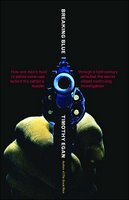Breaking Blue
 “Fresh on a job that promised not only a guaranteed salary of twenty-seven dollars a week but clean clothes as well, Bill Parsons was given a leather strap, brass knuckles, an oak billy club, and a six-chamber, five-inch-barreled, 38-caliber Smith & Wesson, and was introduced to the routine of a lawman in a town staggered by the sixth year of the Great Depression.”
“Fresh on a job that promised not only a guaranteed salary of twenty-seven dollars a week but clean clothes as well, Bill Parsons was given a leather strap, brass knuckles, an oak billy club, and a six-chamber, five-inch-barreled, 38-caliber Smith & Wesson, and was introduced to the routine of a lawman in a town staggered by the sixth year of the Great Depression.”“During the early part of Bill Parson’s career, crime [in Spokane] was tolerated so long as it was the right kind of crime. Bootlegging. Cathouses. Gambling. Wife-beating. Gun-running. No harm there . . .”
The Lady of the Lake reminded me the other day of a book I read back in 1995 called Breaking Blue (1992.) Written by NY Times correspondent Timothy Egan, it’s the engrossing story of a 1935 murder in the town of Newport, WA.
“A rancher’s son, born when followers of Chief Joseph of the Nez Perce still dreamed of driving homesteaders from the ponderosa pine forests and alfalfa fields of the inland Pacific Northwest, . . . Bill Parsons had seen the length of the twentieth century . . .
“He started in police work at a time when bootleggers and Chinese numbers rackets could provide a patrolman with a healthy income on the side, and he got out just before crack dealers and the state lottery commission made a mockery of the Depression-era enforcement routine.”
In 1989 Tony Bamonte was asking questions.
“Bamonte was pursuing a master’s degree at Gonzaga University, the old Jesuit college that was built on the banks of the Spokane River at a time when most of the people who lived near its shores were native Spokane or Coeur d’Alene Indians.”
His thesis was a history of the sheriffs of Pend Oreille County. He was the current sheriff and the murder from 54 years before was still unsolved, an open case sitting on his desk.
The clues in this murder mystery led to the bedside of the now-dying Parsons, so Bamonte called the former Spokane police chief and asked for an interview. He wanted to know about the Newport Creamery murder.
“That same week in September 1989, there had been a story in the paper about drug gang members from Los Angeles moving to the Northwest; they would kill one another over the color of somebody’s hat, the story said. Imagine. But Parsons now recalled a day when one man would shoot another over a few pounds of stolen butter.”
Egan’s book is still in print and available at Barnes & Noble.


0 Comments:
Post a Comment
Subscribe to Post Comments [Atom]
<< Home